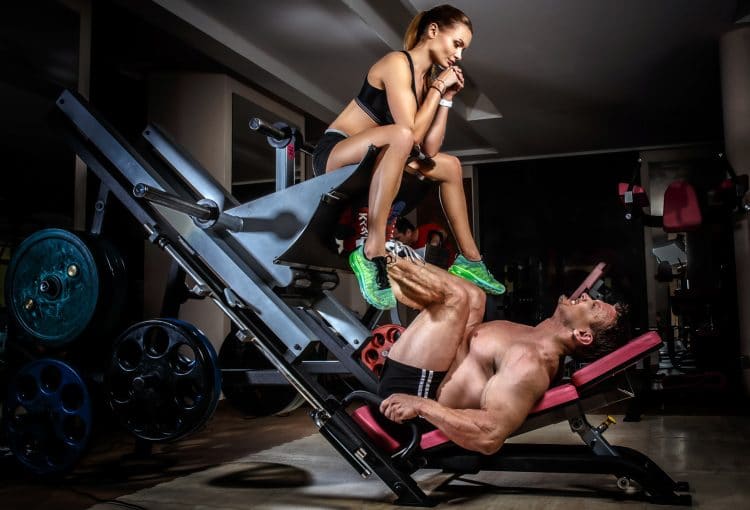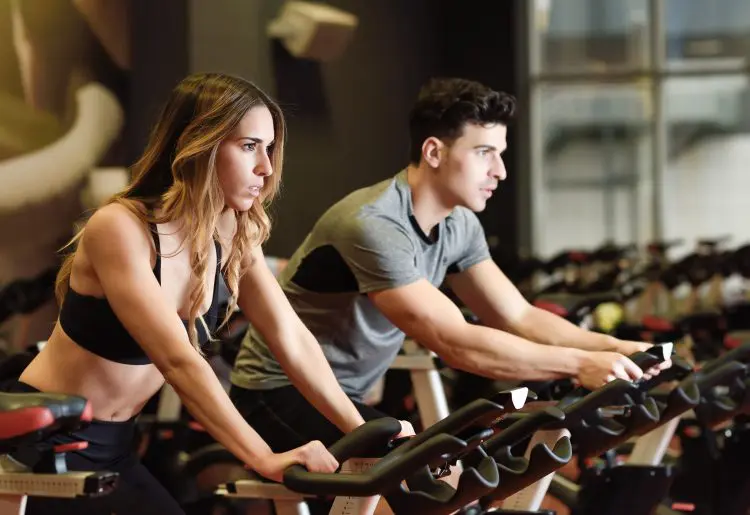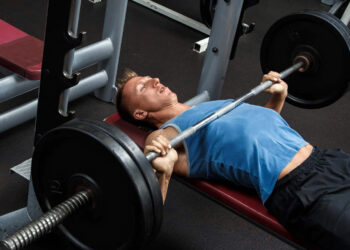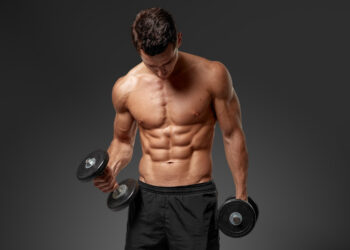Just as cars have proven to be more efficient than the traditional horse and cart, certain machine exercises surpass their freeweight equivalents in efficiency.
Modern machines often feature off-center cams, adjusting resistance throughout the movement, keeping muscles engaged and under constant tension. This dynamic offers a potentially more impactful workout.
The unique designs of these machines enable training muscles from angles nearly impossible to achieve with free weights. Moreover, machines ensure the weight is balanced and guided, allowing individuals to concentrate solely on maximizing their muscle exertion. This setup minimizes the risk of weaker synergist and fixator muscles ending your set prematurely.
Another advantage of machines? They offer a safety net, reducing the risk of being trapped under heavy weights.
However, not everyone is on board with these machine benefits. Many fitness enthusiasts critique machines, pointing out the lack of functionality in exercises like leg extensions or Smith machine bench presses.
And they’re not entirely wrong.
Level Up Your Fitness: Join our 💪 strong community in Fitness Volt Newsletter. Get daily inspiration, expert-backed workouts, nutrition tips, the latest in strength sports, and the support you need to reach your goals. Subscribe for free!
In the real world, weights aren’t neatly guided by rods. They have the freedom to shift in almost any direction. Still, for bodybuilders, whose primary goal is muscle mass rather than functionality or strength, machines might be the most beneficial tool in their arsenal.
With insights from Patrick Dale and updated by Andrew Peloquin, a NFPT-Certified Personal Trainer, this article aims to provide a comprehensive four-day workout for bodybuilders using only resistance machines.
Machine-Only Workouts – Overview
This workout is built around a four-way split. This means you’ll be training four days per week. A four-way split is ideal for beginner and intermediate exercisers and provides a good balance between training and rest days.
This is your training schedule for the next 6-8 weeks:
| Mon | Tue | Wed | Thu | Fri | Sat | Sun |
| Legs & Abs | Chest & Biceps | Rest | Back & Triceps | Rest | Shoulders & Arms | Rest |
As you can see, each workout includes a major muscle group and a minor muscle group. This approach makes good use of both your time and energy.
And yes, we’ve purposely programmed in two workouts for your biceps and triceps. After all, show us a bodybuilder who says they don’t want bigger arms, and we’ll show you a liar!
While you are free to move the workouts according to your schedule, try to keep them in the same order. We’ve created this order to ensure that one workout won’t negatively impact your performance of the next.
For example, it would be a mistake to try and train your chest and shoulders on consecutive days as both workouts involve many of the same muscles.
Finally, if you want to add some cardio to this workout plan, you are free to do so. Either do it AFTER your workout or on your rest days. 20-30 minutes 2-4 times per week should be more than enough.
Workout 1 – Legs & Abs
While Monday is National Chest Day in a lot of gyms, it actually makes more sense to start your training week with a leg workout. Leg training is tiring and tough, so it’s best done when you’ve got plenty of energy.
This workout includes a superset, designated 2a and 2b on the chart below. Supersets are paired exercises. Do 10-12 leg extensions and then immediately do 10-12 leg curls. Rest for one minute, and then repeat the pairing. Do three supersets in total.
Machine-Only Leg Workout
| # | Exercise | Sets | Reps | Recovery |
| 1 | Leg press | 4 | 6-8 | 2 minutes |
| 2a | Leg extension | 3 | 10-12 | 60 seconds |
| 2b | Leg curl | |||
| 3 | Smith machine reverse lunge | 3 | 10-12 per leg | 60 seconds |
| 4 | Hack squat | 3 | 8-10 | 90 seconds |
| 5 | Seated calf raise | 3 | 10-12 | 60 seconds |
| 6 | Standing calf raise | 3 | 12-15 | 60 seconds |
Workout 2 – Chest & Biceps
Today’s workout will probably be your favorite of the week. Every bodybuilder loves training their chest and biceps, so we’ve paired these two popular muscle groups together. By using a push-pull structure, your biceps will be fresh, and you’ll be free to work your arms harder than if you did chest and triceps.
For your first exercise, Smith machine bench presses, you are going to do an ascending weight pyramid. This means you start light and increase the weight set by set. For example:
- 12 reps – 40kg/90lbs
- 10 reps – 50kg/110lbs
- 8 reps – 60kg/135lbs
- 6 reps – 70kg/155lbs
Machine-Only Chest and Biceps Workout
| # | Exercise | Sets | Reps | Recovery |
| 1 | Smith machine bench press | 4 | 12, 10, 8, 6 | 90 seconds |
| 2 | Cable crossover | 3 | 10-12 | 60 seconds |
| 3 | Chest press machine | 3 | 8-10 | 60 seconds |
| 4 | Pec deck | 3 | 12-15 | 60 seconds |
| 5 | Machine dips | 3 | 8-10 | 60 seconds |
| 6 | Triceps pushdown | 3 | 10-12 | 60 seconds |
Workout 3 – Back & Triceps
If you’ve followed our weekly plan, yesterday was a rest day, and you should have plenty of energy to work your back and biceps. This is a demanding workout, but it’s also the last hard one of the week, and tomorrow is another rest day.
This workout includes cable upright rows, which some people view as a shoulder exercise. While the deltoids ARE involved in upright rows, so too is the trapezius, which is very much a back muscle. As such, upright rows fit nicely into back OR shoulder workouts.
Machine-Only Back and Triceps Workout
| # | Exercise | Sets | Reps | Recovery |
| 1 | Lat pulldown | 4 | 8-10 | 90 seconds |
| 2 | Seated cable row | 4 | 8-10 | 90 seconds |
| 3 | Straight arm pulldown | 3 | 10-12 | 60 seconds |
| 4 | Cable upright row | 3 | 10-12 | 60 seconds |
| 5 | Supine cable curl | 3 | 8-10 | 60 seconds |
| 6 | Cable concentration curl | 3 | 10-12 per arm | 60 seconds |
Workout 4 – Shoulders & Arms
This workout is arguably the easiest of the four, which is why it’s at the end of your training week. After completing three demanding workouts, you’re probably feeling more than a little tired. Doing the easiest workout last means that, even though you’ve pushed yourself to the limit all week long, you should still have enough energy to give this final session your best effort.
There are two supersets in this workout, designated 4a and 4b, and 5a and 5b. Doing a biceps and a triceps exercise back-to-back saves time, enhances recovery, and also produces a better pump. Getting a good arm pump is the perfect way to end your training week!
Machine-Only Shoulders & Arms Workout
| # | Exercise | Sets | Reps | Recovery |
| 1 | Smith machine military press | 4 | 6-8 | 90 seconds |
| 2 | Cable lateral raise | 3 | 10-12 | 60 seconds |
| 3 | Face pull | 3 | 12-15 | 60 seconds |
| 4a | Behind the back one-arm cable curl | 3 | 8-10 | 60 seconds |
| 4b | Cable skull crusher | |||
| 5a | Cable hammer curl | 3 | 10-12 | 60 seconds |
| 5b | Reverse grip triceps pushdown |
[Related: 18 Best Smith Machine Exercises]
FAQ’s
Got a question about this workout plan? We’ve got the answers!
Level Up Your Fitness: Join our 💪 strong community in Fitness Volt Newsletter. Get daily inspiration, expert-backed workouts, nutrition tips, the latest in strength sports, and the support you need to reach your goals. Subscribe for free!
1. Is this a bulking or cutting workout?
Good question! The answer really depends on your diet. If you consume more calories than usual, this workout could help you bulk up. But, if you are operating with a calorie deficit, this workout will help you lose fat and get ripped. So, adjust your diet according to your body composition goal.
2. Can I change any of the exercises?
Depending on the equipment you have available, you may not be able to do all the prescribed exercises. In that case, feel free to make any necessary changes so you can follow this workout.
But, try to stay true to the spirit of the workout by using similar exercises. So, while you could do machine chest presses instead of Smith machine bench presses, you should not do calf raises instead of leg presses as they’re too dissimilar.
Finally, don’t ditch exercises just because you find them difficult. In almost every case, the most challenging exercises are also the most productive.
3. What weights should I lift?
Unfortunately, this question is impossible to answer because we have no way of knowing how strong you are. So, choose weights that cause you to fail somewhere within the specified rep range.
If the workout calls for 8-10 reps, if you can’t manage eight, the weight is too heavy, but if you can do more than ten, it’s too light. It’ll take a week or two to determine the correct weights, so just take every set to close to failure regardless of how many reps it takes to get you there.
Remember to try and increase your weights every week or so to ensure you continue to get stronger and more muscular. Alternatively, try and do one extra rep per week with the same weight. Either way, small, gradual increases are vital for your long-term progress.
4. How should I warm-up before each workout?
Warming up is a crucial part of working out. It prepares your body and mind for what you are about to do. That said, there is no need to spend 30 minutes warming up as that’s just a waste of time and energy.
Do 5-10 minutes of easy to moderate intensity cardio to raise your core temperature, followed by a few minutes of dynamic flexibility and mobility exercises for the joints and muscles you are about to train. Finish off your warm-up with 1-2 light sets of your first exercise. That should be more than enough to get you ready for your workout.
5. Aren’t machine exercises like Smith machine bench presses dangerous?
Any exercise done incorrectly can be dangerous. Also, you can get hurt even if you use good technique as, sometimes, accidents just happen. For example, lift too much weight, and you could pull a muscle.
Machine exercises are no more dangerous than freeweight exercises. However, you must make sure you adjust the machine correctly and use it properly. If in doubt, ask the staff at your gym to show you how.
6. Can I add a cardio finisher to these workouts?
Cardio finishers are designed to increase fat burning and fitness. A finisher is a short mini-workout that you tack on to the end of your regular workout. Most last between 5-15 minutes.
If you’ve got the time and the energy for a finisher, by all means, add one to your workout. However, you may not feel like doing one after leg day!
[Read also: You’ll find plenty of finishers to try in this article]
7. Can I replace some of the machine exercises with freeweight or bodyweight exercises?
Just because we’ve written this workout around machine exercises doesn’t mean you can’t make changes if you wish. For example, you might prefer to do pull-ups to lat pulldowns or barbell curls instead of cable curls.
So long as you choose similar exercises, you are free to make whatever substitutions you want. But the more changes you make, the further you’ll get from the original program, and the more likely you are to make it less effective, so don’t make changes just for the sake of it.
8. What supplements should I take during this workout plan?
Contrary to what many people think, you don’t have to take supplements when you work out. In theory, you should be able to get all the nutrients you need from the food in your diet.
That said, there are a few products that can help you make faster progress. Useful supplements include:
That’s not to say you need any or all of these supplements, but if you want to try and make better progress in less time, they could be helpful.
9. Can a beginner do this workout?
Machine-based workouts are ideal for beginners. The exercises are generally easier to learn than most freeweight exercises, and you don’t have to worry about things like dropping a weight on yourself.
That said, this is quite a high-volume plan, so if you are new to working out, you may be better off doing just do 1-2 sets of each exercise for the first few weeks. Ease yourself into training to avoid unnecessary aches and pains.
10. How long should I follow this plan?
There are no hard and fast rules for how long you should stick with a particular program. It all depends on you! Continue with the plan for as long as it’s producing the results you want, i.e., you’re getting stronger. If your weights have stalled for a couple of weeks, you may have plateaued and are ready for a new workout.
So, depending on your results, you could end up following this plan for anywhere from four to 12 weeks.
Wrapping Up
Machine-based workouts are great for less experienced exercisers. Still, you don’t have to be a beginner to benefit from training with machines. Using machines allows you to isolate your muscles and train to failure in relative safety, making your workouts more intense and productive.
You can also use machines for things like drop sets and partial reps, which are training systems aimed mainly at more advanced bodybuilders.
So, don’t jump on the “we hate machines” bandwagon and only use freeweights or bodyweight exercises in your workouts.
Machines are just another tool you can use to reach your fitness and physique goals. There is no such thing as a bad exercise. The trick is to use the best exercise for your training objective.
Sometimes, that will be a barbell exercise, but other times, it could be a machine.
More Bodybuilding Workouts:
- Freeweight-only Bodybuilding Workout
- Equipment-Free Bodybuilding Workout
- Bodybuilding Workout for Big Pecs
- 12 Best Trisets for Bodybuilding
- Most Intense Bodybuilding Methods
- 12 Bodybuilding Mistakes That Are Killing Your Gains
- 13 Tools for More Productive Bodybuilding Workouts













